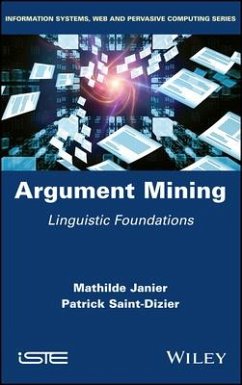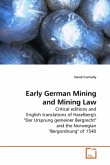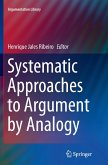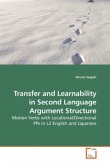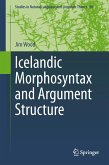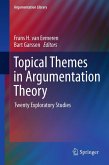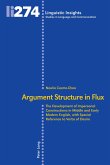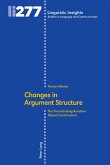- Gebundenes Buch
- Merkliste
- Auf die Merkliste
- Bewerten Bewerten
- Teilen
- Produkt teilen
- Produkterinnerung
- Produkterinnerung
This book is an introduction to the linguistic concepts of argumentation relevant for argument mining, an important research and development activity which can be viewed as a highly complex form of information retrieval, requiring high-level natural language processing technology. While the first four chapters develop the linguistic and conceptual aspects of argument expression, the last four are devoted to their application to argument mining. These chapters investigate the facets of argument annotation, as well as argument mining system architectures and evaluation. How annotations may be…mehr
Andere Kunden interessierten sich auch für
![Early German Mining and Mining Law Early German Mining and Mining Law]() David ConnollyEarly German Mining and Mining Law53,99 €
David ConnollyEarly German Mining and Mining Law53,99 €![Systematic Approaches to Argument by Analogy Systematic Approaches to Argument by Analogy]() Systematic Approaches to Argument by Analogy77,99 €
Systematic Approaches to Argument by Analogy77,99 €![Transfer and Learnability in Second Language Argument Structure Transfer and Learnability in Second Language Argument Structure]() Shunji InagakiTransfer and Learnability in Second Language Argument Structure53,99 €
Shunji InagakiTransfer and Learnability in Second Language Argument Structure53,99 €![Icelandic Morphosyntax and Argument Structure Icelandic Morphosyntax and Argument Structure]() Jim WoodIcelandic Morphosyntax and Argument Structure77,99 €
Jim WoodIcelandic Morphosyntax and Argument Structure77,99 €![Topical Themes in Argumentation Theory Topical Themes in Argumentation Theory]() Topical Themes in Argumentation Theory77,99 €
Topical Themes in Argumentation Theory77,99 €![Argument Structure in Flux Argument Structure in Flux]() Noelia Castro-ChaoArgument Structure in Flux66,75 €
Noelia Castro-ChaoArgument Structure in Flux66,75 €![Changes in Argument Structure Changes in Argument Structure]() Tamara Bouso-RivasChanges in Argument Structure70,10 €
Tamara Bouso-RivasChanges in Argument Structure70,10 €-
-
-
This book is an introduction to the linguistic concepts of argumentation relevant for argument mining, an important research and development activity which can be viewed as a highly complex form of information retrieval, requiring high-level natural language processing technology. While the first four chapters develop the linguistic and conceptual aspects of argument expression, the last four are devoted to their application to argument mining. These chapters investigate the facets of argument annotation, as well as argument mining system architectures and evaluation. How annotations may be used to develop linguistic data and how to train learning algorithms is outlined. A simple implementation is then proposed. The book ends with an analysis of non-verbal argumentative discourse. Argument Mining is an introductory book for engineers or students of linguistics, artificial intelligence and natural language processing. Most, if not all, the concepts of argumentation crucial for argument mining are carefully introduced and illustrated in a simple manner.
Hinweis: Dieser Artikel kann nur an eine deutsche Lieferadresse ausgeliefert werden.
Hinweis: Dieser Artikel kann nur an eine deutsche Lieferadresse ausgeliefert werden.
Produktdetails
- Produktdetails
- Verlag: Wiley
- Seitenzahl: 208
- Erscheinungstermin: 12. Dezember 2019
- Englisch
- Abmessung: 236mm x 160mm x 18mm
- Gewicht: 458g
- ISBN-13: 9781786303035
- ISBN-10: 1786303035
- Artikelnr.: 57635919
- Herstellerkennzeichnung
- Libri GmbH
- Europaallee 1
- 36244 Bad Hersfeld
- gpsr@libri.de
- Verlag: Wiley
- Seitenzahl: 208
- Erscheinungstermin: 12. Dezember 2019
- Englisch
- Abmessung: 236mm x 160mm x 18mm
- Gewicht: 458g
- ISBN-13: 9781786303035
- ISBN-10: 1786303035
- Artikelnr.: 57635919
- Herstellerkennzeichnung
- Libri GmbH
- Europaallee 1
- 36244 Bad Hersfeld
- gpsr@libri.de
Mathilde Janier has co-authored over 15 publications, principally dealing with the annotation and modeling of argumentative dynamics in debate and dispute mediation. Her work mainly focuses on argumentation in dialogical contexts. Patrick Saint-Dizier is Senior Researcher at CNRS ? IRIT Toulouse, France. His work is based on logic, language, argumentation, natural language processing and logic programming. He is the author and co-author of 11 books on these topics.
Preface xi
Chapter 1. Introduction and Challenges 1
1.1. What is argumentation? 1
1.2. Argumentation and argument mining 4
1.3. The origins of argumentation 7
1.4. The argumentative discourse 8
1.5. Contemporary trends 10
Chapter 2. The Structure of Argumentation 13
2.1. The argument-conclusion pair 13
2.2. The elementary argumentative schema 14
2.2.1. Toulmin's argumentative model 14
2.2.2. Some elaborations and refinements of Toulmin's model 17
2.2.3. The geometry of arguments 18
2.3. Modeling agreement and disagreement 20
2.3.1. Agreeing versus disagreeing 20
2.3.2. The art of resolving divergences 23
2.4. The structure of an argumentation: argumentation graphs 25
2.5. The role of argument schemes in argumentation 27
2.5.1. Argument schemes: main concepts 27
2.5.2. A few simple illustrations 28
2.5.3. Argument schemes based on analogy 29
2.5.4. Argument schemes based on causality 30
2.6. Relations between Toulmin's model and argumentation schemes 31
2.6.1. Warrants as a popular opinion 32
2.6.2. Argument schemes based on rules, explanations or hypothesis 34
2.6.3. Argument schemes based on multiple supports or attacks 35
2.6.4. Causality and warrants 37
Chapter 3. The Linguistics of Argumentation 39
3.1. The structure of claims 40
3.2. The linguistics of justifications 45
3.3. Evaluating the strength of claims, justifications and arguments 47
3.3.1. Strength factors within a proposition 49
3.3.2. Structuring expressions of strength by semantic category 51
3.3.3. A simple representation of strength when combining several factors
52
3.3.4. Pragmatic factors of strength expression 53
3.4. Rhetoric and argumentation 59
3.4.1. Rhetoric and communication 60
3.4.2. Logos: the art of reasoning and of constructing demonstrations 61
3.4.3. Ethos: the orator profile 62
3.4.4. Pathos: how to persuade an audience 63
Chapter 4. Advanced Features of Argumentation for Argument Mining 65
4.1. Managing incoherent claims and justifications 65
4.1.1. The case of justifications supporting opposite claims 66
4.1.2. The case of opposite justifications justifying the same claim 67
4.2. Relating claims and justifications: the need for knowledge and
reasoning 67
4.2.1. Investigating relatedness via corpus analysis 68
4.2.2. A corpus analysis of the knowledge involved 69
4.2.3. Observation synthesis 72
4.3. Argument synthesis in natural language 74
4.3.1. Features of a synthesis 75
4.3.2. Structure of an argumentation synthesis 76
Chapter 5. From Argumentation to Argument Mining 79
5.1. Some facets of argument mining 79
5.2. Designing annotation guidelines: some methodological elements 81
5.3. What results can be expected from an argument mining system? 82
5.4. Architecture of an argument mining system 83
5.5. The next chapters 84
Chapter 6. Annotation Frameworks and Principles of Argument Analysis 85
6.1. Principles of argument analysis 86
6.1.1. Argumentative discourse units 86
6.1.2. Conclusions and premises 88
6.1.3. Warrants and backings 89
6.1.4. Qualifiers 89
6.1.5. Argument schemes 90
6.1.6. Attack relations: rebuttals, refutations, undercutters 90
6.1.7. Illocutionary forces, speech acts 92
6.1.8. Argument relations 93
6.1.9. Implicit argument components and tailored annotation frameworks 95
6.2. Examples of argument analysis frameworks 97
6.2.1. Rhetorical Structure Theory 97
6.2.2. Toulmin's model 98
6.2.3. Inference Anchoring Theory 99
6.2.4. Summary 102
6.3. Guidelines for argument analysis 103
6.3.1. Principles of annotation guidelines 103
6.3.2. Inter-annotator agreements 104
6.3.3. Interpretation of IAA measures 105
6.3.4. Some examples of IAAs 106
6.3.5. Summary 107
6.4. Annotation tools 108
6.4.1. Brat 108
6.4.2. RST tool 109
6.4.3. AGORA-net 110
6.4.4. Araucaria 110
6.4.5. Rationale 111
6.4.6. OVA+ 112
6.4.7. Summary 113
6.5. Argument corpora 114
6.5.1. COMARG 115
6.5.2. A news editorial corpus 115
6.5.3. THF Airport ArgMining corpus 115
6.5.4. A Wikipedia articles corpus 115
6.5.5. AraucariaDB 115
6.5.6. An annotated essays corpus 116
6.5.7. A written dialogs corpus 116
6.5.8. A web discourse corpus 116
6.5.9. Argument Interchange Format Database 116
6.5.10. Summary 117
6.6. Conclusion 118
Chapter 7. Argument Mining Applications and Systems 119
7.1. Application domains for argument mining 119
7.1.1. Opinion analysis augmented by argument mining 120
7.1.2. Summarization 120
7.1.3. Essays 120
7.1.4. Dialogues 120
7.1.5. Scientific and news articles 120
7.1.6. The web 121
7.1.7. Legal field 121
7.1.8. Medical field 121
7.1.9. Education 121
7.2. Principles of argument mining systems 122
7.2.1. Argumentative discourse units detection 123
7.2.2. Units labeling 123
7.2.3. Argument structure detection 124
7.2.4. Argument completion 125
7.2.5. Argument structure representation 125
7.3. Some existing systems for argument mining 126
7.3.1. Automatic detection of rhetorical relations 126
7.3.2. Argument zoning 126
7.3.3. Stance detection 127
7.3.4. Argument mining for persuasive essays 127
7.3.5. Argument mining for web discourse 127
7.3.6. Argument mining for social media 128
7.3.7. Argument scheme classification and enthymemes reconstruction 128
7.3.8. Argument classes and argument strength classification 128
7.3.9. Textcoop 129
7.3.10. IBM debating technologies 129
7.3.11. Argument mining for legal texts 129
7.4. Efficiency and limitations of existing argument mining systems 130
7.5. Conclusion 131
Chapter 8. A Computational Model and a Simple Grammar-Based Implementation
133
8.1. Identification of argumentative units 134
8.1.1. Challenges raised by the identification of argumentative units 134
8.1.2. Some linguistic techniques to identify ADUs 135
8.2. Mining for claims 139
8.2.1. The grammar formalisms 140
8.2.2. Lexical issues 142
8.2.3. Grammatical issues 145
8.2.4. Templates for claim analysis 148
8.3. Mining for supports and attacks 150
8.3.1. Structures introduced by connectors 150
8.3.2. Structures introduced by propositional attitudes 151
8.3.3. Other linguistic forms to express supports or attacks 152
8.4. Evaluating strength 153
8.5. Epilogue 154
Chapter 9. Non-Verbal Dimensions of Argumentation: a Challenge for Argument
Mining 155
9.1. The text and its additions 156
9.1.1. Text, pictures and icons 156
9.1.2. Transcriptions of oral debates 156
9.2. Argumentation and visual aspects 157
9.3. Argumentation and sound aspects 158
9.3.1. Music and rationality 159
9.3.2. Main features of musical structure: musical knowledge representation
160
9.4. Impact of non-verbal aspects on argument strength and on argument
schemes 161
9.5. Ethical aspects 162
Bibliography 163
Index 175
Chapter 1. Introduction and Challenges 1
1.1. What is argumentation? 1
1.2. Argumentation and argument mining 4
1.3. The origins of argumentation 7
1.4. The argumentative discourse 8
1.5. Contemporary trends 10
Chapter 2. The Structure of Argumentation 13
2.1. The argument-conclusion pair 13
2.2. The elementary argumentative schema 14
2.2.1. Toulmin's argumentative model 14
2.2.2. Some elaborations and refinements of Toulmin's model 17
2.2.3. The geometry of arguments 18
2.3. Modeling agreement and disagreement 20
2.3.1. Agreeing versus disagreeing 20
2.3.2. The art of resolving divergences 23
2.4. The structure of an argumentation: argumentation graphs 25
2.5. The role of argument schemes in argumentation 27
2.5.1. Argument schemes: main concepts 27
2.5.2. A few simple illustrations 28
2.5.3. Argument schemes based on analogy 29
2.5.4. Argument schemes based on causality 30
2.6. Relations between Toulmin's model and argumentation schemes 31
2.6.1. Warrants as a popular opinion 32
2.6.2. Argument schemes based on rules, explanations or hypothesis 34
2.6.3. Argument schemes based on multiple supports or attacks 35
2.6.4. Causality and warrants 37
Chapter 3. The Linguistics of Argumentation 39
3.1. The structure of claims 40
3.2. The linguistics of justifications 45
3.3. Evaluating the strength of claims, justifications and arguments 47
3.3.1. Strength factors within a proposition 49
3.3.2. Structuring expressions of strength by semantic category 51
3.3.3. A simple representation of strength when combining several factors
52
3.3.4. Pragmatic factors of strength expression 53
3.4. Rhetoric and argumentation 59
3.4.1. Rhetoric and communication 60
3.4.2. Logos: the art of reasoning and of constructing demonstrations 61
3.4.3. Ethos: the orator profile 62
3.4.4. Pathos: how to persuade an audience 63
Chapter 4. Advanced Features of Argumentation for Argument Mining 65
4.1. Managing incoherent claims and justifications 65
4.1.1. The case of justifications supporting opposite claims 66
4.1.2. The case of opposite justifications justifying the same claim 67
4.2. Relating claims and justifications: the need for knowledge and
reasoning 67
4.2.1. Investigating relatedness via corpus analysis 68
4.2.2. A corpus analysis of the knowledge involved 69
4.2.3. Observation synthesis 72
4.3. Argument synthesis in natural language 74
4.3.1. Features of a synthesis 75
4.3.2. Structure of an argumentation synthesis 76
Chapter 5. From Argumentation to Argument Mining 79
5.1. Some facets of argument mining 79
5.2. Designing annotation guidelines: some methodological elements 81
5.3. What results can be expected from an argument mining system? 82
5.4. Architecture of an argument mining system 83
5.5. The next chapters 84
Chapter 6. Annotation Frameworks and Principles of Argument Analysis 85
6.1. Principles of argument analysis 86
6.1.1. Argumentative discourse units 86
6.1.2. Conclusions and premises 88
6.1.3. Warrants and backings 89
6.1.4. Qualifiers 89
6.1.5. Argument schemes 90
6.1.6. Attack relations: rebuttals, refutations, undercutters 90
6.1.7. Illocutionary forces, speech acts 92
6.1.8. Argument relations 93
6.1.9. Implicit argument components and tailored annotation frameworks 95
6.2. Examples of argument analysis frameworks 97
6.2.1. Rhetorical Structure Theory 97
6.2.2. Toulmin's model 98
6.2.3. Inference Anchoring Theory 99
6.2.4. Summary 102
6.3. Guidelines for argument analysis 103
6.3.1. Principles of annotation guidelines 103
6.3.2. Inter-annotator agreements 104
6.3.3. Interpretation of IAA measures 105
6.3.4. Some examples of IAAs 106
6.3.5. Summary 107
6.4. Annotation tools 108
6.4.1. Brat 108
6.4.2. RST tool 109
6.4.3. AGORA-net 110
6.4.4. Araucaria 110
6.4.5. Rationale 111
6.4.6. OVA+ 112
6.4.7. Summary 113
6.5. Argument corpora 114
6.5.1. COMARG 115
6.5.2. A news editorial corpus 115
6.5.3. THF Airport ArgMining corpus 115
6.5.4. A Wikipedia articles corpus 115
6.5.5. AraucariaDB 115
6.5.6. An annotated essays corpus 116
6.5.7. A written dialogs corpus 116
6.5.8. A web discourse corpus 116
6.5.9. Argument Interchange Format Database 116
6.5.10. Summary 117
6.6. Conclusion 118
Chapter 7. Argument Mining Applications and Systems 119
7.1. Application domains for argument mining 119
7.1.1. Opinion analysis augmented by argument mining 120
7.1.2. Summarization 120
7.1.3. Essays 120
7.1.4. Dialogues 120
7.1.5. Scientific and news articles 120
7.1.6. The web 121
7.1.7. Legal field 121
7.1.8. Medical field 121
7.1.9. Education 121
7.2. Principles of argument mining systems 122
7.2.1. Argumentative discourse units detection 123
7.2.2. Units labeling 123
7.2.3. Argument structure detection 124
7.2.4. Argument completion 125
7.2.5. Argument structure representation 125
7.3. Some existing systems for argument mining 126
7.3.1. Automatic detection of rhetorical relations 126
7.3.2. Argument zoning 126
7.3.3. Stance detection 127
7.3.4. Argument mining for persuasive essays 127
7.3.5. Argument mining for web discourse 127
7.3.6. Argument mining for social media 128
7.3.7. Argument scheme classification and enthymemes reconstruction 128
7.3.8. Argument classes and argument strength classification 128
7.3.9. Textcoop 129
7.3.10. IBM debating technologies 129
7.3.11. Argument mining for legal texts 129
7.4. Efficiency and limitations of existing argument mining systems 130
7.5. Conclusion 131
Chapter 8. A Computational Model and a Simple Grammar-Based Implementation
133
8.1. Identification of argumentative units 134
8.1.1. Challenges raised by the identification of argumentative units 134
8.1.2. Some linguistic techniques to identify ADUs 135
8.2. Mining for claims 139
8.2.1. The grammar formalisms 140
8.2.2. Lexical issues 142
8.2.3. Grammatical issues 145
8.2.4. Templates for claim analysis 148
8.3. Mining for supports and attacks 150
8.3.1. Structures introduced by connectors 150
8.3.2. Structures introduced by propositional attitudes 151
8.3.3. Other linguistic forms to express supports or attacks 152
8.4. Evaluating strength 153
8.5. Epilogue 154
Chapter 9. Non-Verbal Dimensions of Argumentation: a Challenge for Argument
Mining 155
9.1. The text and its additions 156
9.1.1. Text, pictures and icons 156
9.1.2. Transcriptions of oral debates 156
9.2. Argumentation and visual aspects 157
9.3. Argumentation and sound aspects 158
9.3.1. Music and rationality 159
9.3.2. Main features of musical structure: musical knowledge representation
160
9.4. Impact of non-verbal aspects on argument strength and on argument
schemes 161
9.5. Ethical aspects 162
Bibliography 163
Index 175
Preface xi
Chapter 1. Introduction and Challenges 1
1.1. What is argumentation? 1
1.2. Argumentation and argument mining 4
1.3. The origins of argumentation 7
1.4. The argumentative discourse 8
1.5. Contemporary trends 10
Chapter 2. The Structure of Argumentation 13
2.1. The argument-conclusion pair 13
2.2. The elementary argumentative schema 14
2.2.1. Toulmin's argumentative model 14
2.2.2. Some elaborations and refinements of Toulmin's model 17
2.2.3. The geometry of arguments 18
2.3. Modeling agreement and disagreement 20
2.3.1. Agreeing versus disagreeing 20
2.3.2. The art of resolving divergences 23
2.4. The structure of an argumentation: argumentation graphs 25
2.5. The role of argument schemes in argumentation 27
2.5.1. Argument schemes: main concepts 27
2.5.2. A few simple illustrations 28
2.5.3. Argument schemes based on analogy 29
2.5.4. Argument schemes based on causality 30
2.6. Relations between Toulmin's model and argumentation schemes 31
2.6.1. Warrants as a popular opinion 32
2.6.2. Argument schemes based on rules, explanations or hypothesis 34
2.6.3. Argument schemes based on multiple supports or attacks 35
2.6.4. Causality and warrants 37
Chapter 3. The Linguistics of Argumentation 39
3.1. The structure of claims 40
3.2. The linguistics of justifications 45
3.3. Evaluating the strength of claims, justifications and arguments 47
3.3.1. Strength factors within a proposition 49
3.3.2. Structuring expressions of strength by semantic category 51
3.3.3. A simple representation of strength when combining several factors
52
3.3.4. Pragmatic factors of strength expression 53
3.4. Rhetoric and argumentation 59
3.4.1. Rhetoric and communication 60
3.4.2. Logos: the art of reasoning and of constructing demonstrations 61
3.4.3. Ethos: the orator profile 62
3.4.4. Pathos: how to persuade an audience 63
Chapter 4. Advanced Features of Argumentation for Argument Mining 65
4.1. Managing incoherent claims and justifications 65
4.1.1. The case of justifications supporting opposite claims 66
4.1.2. The case of opposite justifications justifying the same claim 67
4.2. Relating claims and justifications: the need for knowledge and
reasoning 67
4.2.1. Investigating relatedness via corpus analysis 68
4.2.2. A corpus analysis of the knowledge involved 69
4.2.3. Observation synthesis 72
4.3. Argument synthesis in natural language 74
4.3.1. Features of a synthesis 75
4.3.2. Structure of an argumentation synthesis 76
Chapter 5. From Argumentation to Argument Mining 79
5.1. Some facets of argument mining 79
5.2. Designing annotation guidelines: some methodological elements 81
5.3. What results can be expected from an argument mining system? 82
5.4. Architecture of an argument mining system 83
5.5. The next chapters 84
Chapter 6. Annotation Frameworks and Principles of Argument Analysis 85
6.1. Principles of argument analysis 86
6.1.1. Argumentative discourse units 86
6.1.2. Conclusions and premises 88
6.1.3. Warrants and backings 89
6.1.4. Qualifiers 89
6.1.5. Argument schemes 90
6.1.6. Attack relations: rebuttals, refutations, undercutters 90
6.1.7. Illocutionary forces, speech acts 92
6.1.8. Argument relations 93
6.1.9. Implicit argument components and tailored annotation frameworks 95
6.2. Examples of argument analysis frameworks 97
6.2.1. Rhetorical Structure Theory 97
6.2.2. Toulmin's model 98
6.2.3. Inference Anchoring Theory 99
6.2.4. Summary 102
6.3. Guidelines for argument analysis 103
6.3.1. Principles of annotation guidelines 103
6.3.2. Inter-annotator agreements 104
6.3.3. Interpretation of IAA measures 105
6.3.4. Some examples of IAAs 106
6.3.5. Summary 107
6.4. Annotation tools 108
6.4.1. Brat 108
6.4.2. RST tool 109
6.4.3. AGORA-net 110
6.4.4. Araucaria 110
6.4.5. Rationale 111
6.4.6. OVA+ 112
6.4.7. Summary 113
6.5. Argument corpora 114
6.5.1. COMARG 115
6.5.2. A news editorial corpus 115
6.5.3. THF Airport ArgMining corpus 115
6.5.4. A Wikipedia articles corpus 115
6.5.5. AraucariaDB 115
6.5.6. An annotated essays corpus 116
6.5.7. A written dialogs corpus 116
6.5.8. A web discourse corpus 116
6.5.9. Argument Interchange Format Database 116
6.5.10. Summary 117
6.6. Conclusion 118
Chapter 7. Argument Mining Applications and Systems 119
7.1. Application domains for argument mining 119
7.1.1. Opinion analysis augmented by argument mining 120
7.1.2. Summarization 120
7.1.3. Essays 120
7.1.4. Dialogues 120
7.1.5. Scientific and news articles 120
7.1.6. The web 121
7.1.7. Legal field 121
7.1.8. Medical field 121
7.1.9. Education 121
7.2. Principles of argument mining systems 122
7.2.1. Argumentative discourse units detection 123
7.2.2. Units labeling 123
7.2.3. Argument structure detection 124
7.2.4. Argument completion 125
7.2.5. Argument structure representation 125
7.3. Some existing systems for argument mining 126
7.3.1. Automatic detection of rhetorical relations 126
7.3.2. Argument zoning 126
7.3.3. Stance detection 127
7.3.4. Argument mining for persuasive essays 127
7.3.5. Argument mining for web discourse 127
7.3.6. Argument mining for social media 128
7.3.7. Argument scheme classification and enthymemes reconstruction 128
7.3.8. Argument classes and argument strength classification 128
7.3.9. Textcoop 129
7.3.10. IBM debating technologies 129
7.3.11. Argument mining for legal texts 129
7.4. Efficiency and limitations of existing argument mining systems 130
7.5. Conclusion 131
Chapter 8. A Computational Model and a Simple Grammar-Based Implementation
133
8.1. Identification of argumentative units 134
8.1.1. Challenges raised by the identification of argumentative units 134
8.1.2. Some linguistic techniques to identify ADUs 135
8.2. Mining for claims 139
8.2.1. The grammar formalisms 140
8.2.2. Lexical issues 142
8.2.3. Grammatical issues 145
8.2.4. Templates for claim analysis 148
8.3. Mining for supports and attacks 150
8.3.1. Structures introduced by connectors 150
8.3.2. Structures introduced by propositional attitudes 151
8.3.3. Other linguistic forms to express supports or attacks 152
8.4. Evaluating strength 153
8.5. Epilogue 154
Chapter 9. Non-Verbal Dimensions of Argumentation: a Challenge for Argument
Mining 155
9.1. The text and its additions 156
9.1.1. Text, pictures and icons 156
9.1.2. Transcriptions of oral debates 156
9.2. Argumentation and visual aspects 157
9.3. Argumentation and sound aspects 158
9.3.1. Music and rationality 159
9.3.2. Main features of musical structure: musical knowledge representation
160
9.4. Impact of non-verbal aspects on argument strength and on argument
schemes 161
9.5. Ethical aspects 162
Bibliography 163
Index 175
Chapter 1. Introduction and Challenges 1
1.1. What is argumentation? 1
1.2. Argumentation and argument mining 4
1.3. The origins of argumentation 7
1.4. The argumentative discourse 8
1.5. Contemporary trends 10
Chapter 2. The Structure of Argumentation 13
2.1. The argument-conclusion pair 13
2.2. The elementary argumentative schema 14
2.2.1. Toulmin's argumentative model 14
2.2.2. Some elaborations and refinements of Toulmin's model 17
2.2.3. The geometry of arguments 18
2.3. Modeling agreement and disagreement 20
2.3.1. Agreeing versus disagreeing 20
2.3.2. The art of resolving divergences 23
2.4. The structure of an argumentation: argumentation graphs 25
2.5. The role of argument schemes in argumentation 27
2.5.1. Argument schemes: main concepts 27
2.5.2. A few simple illustrations 28
2.5.3. Argument schemes based on analogy 29
2.5.4. Argument schemes based on causality 30
2.6. Relations between Toulmin's model and argumentation schemes 31
2.6.1. Warrants as a popular opinion 32
2.6.2. Argument schemes based on rules, explanations or hypothesis 34
2.6.3. Argument schemes based on multiple supports or attacks 35
2.6.4. Causality and warrants 37
Chapter 3. The Linguistics of Argumentation 39
3.1. The structure of claims 40
3.2. The linguistics of justifications 45
3.3. Evaluating the strength of claims, justifications and arguments 47
3.3.1. Strength factors within a proposition 49
3.3.2. Structuring expressions of strength by semantic category 51
3.3.3. A simple representation of strength when combining several factors
52
3.3.4. Pragmatic factors of strength expression 53
3.4. Rhetoric and argumentation 59
3.4.1. Rhetoric and communication 60
3.4.2. Logos: the art of reasoning and of constructing demonstrations 61
3.4.3. Ethos: the orator profile 62
3.4.4. Pathos: how to persuade an audience 63
Chapter 4. Advanced Features of Argumentation for Argument Mining 65
4.1. Managing incoherent claims and justifications 65
4.1.1. The case of justifications supporting opposite claims 66
4.1.2. The case of opposite justifications justifying the same claim 67
4.2. Relating claims and justifications: the need for knowledge and
reasoning 67
4.2.1. Investigating relatedness via corpus analysis 68
4.2.2. A corpus analysis of the knowledge involved 69
4.2.3. Observation synthesis 72
4.3. Argument synthesis in natural language 74
4.3.1. Features of a synthesis 75
4.3.2. Structure of an argumentation synthesis 76
Chapter 5. From Argumentation to Argument Mining 79
5.1. Some facets of argument mining 79
5.2. Designing annotation guidelines: some methodological elements 81
5.3. What results can be expected from an argument mining system? 82
5.4. Architecture of an argument mining system 83
5.5. The next chapters 84
Chapter 6. Annotation Frameworks and Principles of Argument Analysis 85
6.1. Principles of argument analysis 86
6.1.1. Argumentative discourse units 86
6.1.2. Conclusions and premises 88
6.1.3. Warrants and backings 89
6.1.4. Qualifiers 89
6.1.5. Argument schemes 90
6.1.6. Attack relations: rebuttals, refutations, undercutters 90
6.1.7. Illocutionary forces, speech acts 92
6.1.8. Argument relations 93
6.1.9. Implicit argument components and tailored annotation frameworks 95
6.2. Examples of argument analysis frameworks 97
6.2.1. Rhetorical Structure Theory 97
6.2.2. Toulmin's model 98
6.2.3. Inference Anchoring Theory 99
6.2.4. Summary 102
6.3. Guidelines for argument analysis 103
6.3.1. Principles of annotation guidelines 103
6.3.2. Inter-annotator agreements 104
6.3.3. Interpretation of IAA measures 105
6.3.4. Some examples of IAAs 106
6.3.5. Summary 107
6.4. Annotation tools 108
6.4.1. Brat 108
6.4.2. RST tool 109
6.4.3. AGORA-net 110
6.4.4. Araucaria 110
6.4.5. Rationale 111
6.4.6. OVA+ 112
6.4.7. Summary 113
6.5. Argument corpora 114
6.5.1. COMARG 115
6.5.2. A news editorial corpus 115
6.5.3. THF Airport ArgMining corpus 115
6.5.4. A Wikipedia articles corpus 115
6.5.5. AraucariaDB 115
6.5.6. An annotated essays corpus 116
6.5.7. A written dialogs corpus 116
6.5.8. A web discourse corpus 116
6.5.9. Argument Interchange Format Database 116
6.5.10. Summary 117
6.6. Conclusion 118
Chapter 7. Argument Mining Applications and Systems 119
7.1. Application domains for argument mining 119
7.1.1. Opinion analysis augmented by argument mining 120
7.1.2. Summarization 120
7.1.3. Essays 120
7.1.4. Dialogues 120
7.1.5. Scientific and news articles 120
7.1.6. The web 121
7.1.7. Legal field 121
7.1.8. Medical field 121
7.1.9. Education 121
7.2. Principles of argument mining systems 122
7.2.1. Argumentative discourse units detection 123
7.2.2. Units labeling 123
7.2.3. Argument structure detection 124
7.2.4. Argument completion 125
7.2.5. Argument structure representation 125
7.3. Some existing systems for argument mining 126
7.3.1. Automatic detection of rhetorical relations 126
7.3.2. Argument zoning 126
7.3.3. Stance detection 127
7.3.4. Argument mining for persuasive essays 127
7.3.5. Argument mining for web discourse 127
7.3.6. Argument mining for social media 128
7.3.7. Argument scheme classification and enthymemes reconstruction 128
7.3.8. Argument classes and argument strength classification 128
7.3.9. Textcoop 129
7.3.10. IBM debating technologies 129
7.3.11. Argument mining for legal texts 129
7.4. Efficiency and limitations of existing argument mining systems 130
7.5. Conclusion 131
Chapter 8. A Computational Model and a Simple Grammar-Based Implementation
133
8.1. Identification of argumentative units 134
8.1.1. Challenges raised by the identification of argumentative units 134
8.1.2. Some linguistic techniques to identify ADUs 135
8.2. Mining for claims 139
8.2.1. The grammar formalisms 140
8.2.2. Lexical issues 142
8.2.3. Grammatical issues 145
8.2.4. Templates for claim analysis 148
8.3. Mining for supports and attacks 150
8.3.1. Structures introduced by connectors 150
8.3.2. Structures introduced by propositional attitudes 151
8.3.3. Other linguistic forms to express supports or attacks 152
8.4. Evaluating strength 153
8.5. Epilogue 154
Chapter 9. Non-Verbal Dimensions of Argumentation: a Challenge for Argument
Mining 155
9.1. The text and its additions 156
9.1.1. Text, pictures and icons 156
9.1.2. Transcriptions of oral debates 156
9.2. Argumentation and visual aspects 157
9.3. Argumentation and sound aspects 158
9.3.1. Music and rationality 159
9.3.2. Main features of musical structure: musical knowledge representation
160
9.4. Impact of non-verbal aspects on argument strength and on argument
schemes 161
9.5. Ethical aspects 162
Bibliography 163
Index 175

